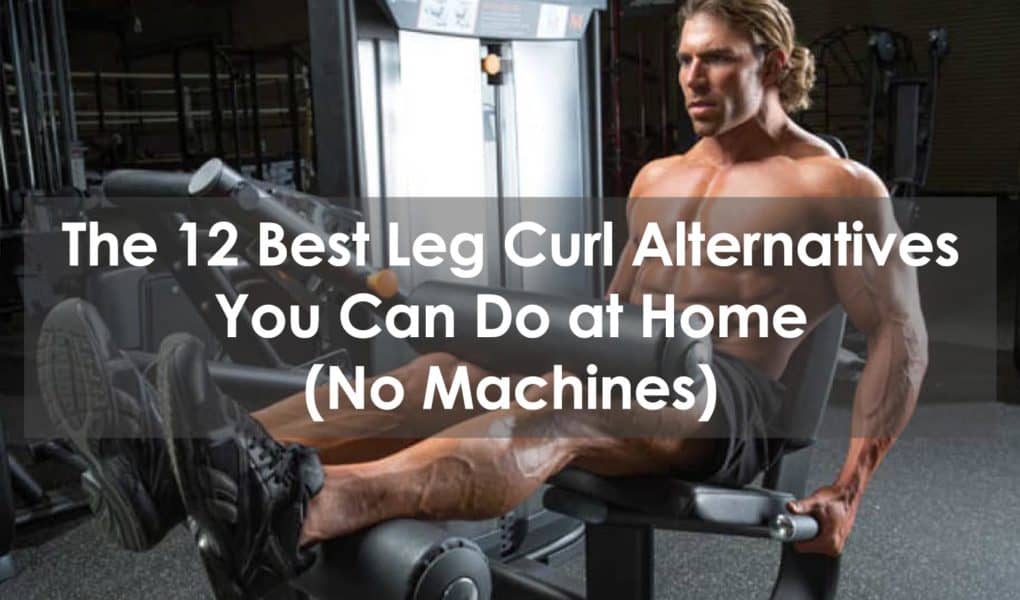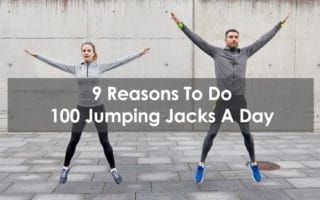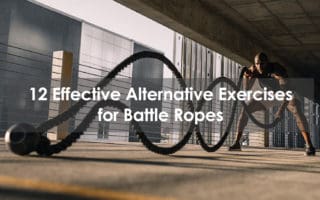I’ve had knee pain from sports. I’ve also had knee pain from everyday living. Sometimes a trip, an accidental slip on ice, or just wear and tear over the years.
Funnily enough, I never got hurt when practicing leg curls regularly. But, when I took time off? Right back to pain.
That’s because the hamstring attaches to the knee and hip. So, when your hamstrings are weak, you’re at risk of injury on both of these joints. As you can imagine, instability causes injury – but strength prevents it.
But what if you need a leg curl alternative? After all, we don’t all have leg curl machines lying around.
Today, I’m taking you through the 12 best leg curl alternatives you can use without a machine. They’ll get your legs and hips strong, protect your lower body joints, and will even have you looking better.
What else could you want? Let’s go…
Our Top 12 Leg Curl Alternatives (Without a Machine)
These are the leg curl alternatives that offer the most bang for your buck.
They’re essential if you don’t have access to a leg curl machine for isolation exercise. They’re also great in their own right – they are excellent lower body exercises for areas like the back, rear thigh (hamstrings), and buttocks.
I’ve ranked them by difficulty so that you can start with #1 and work up the difficulty. This also means that there’s always something for you, no matter your current strength levels!
You can also combine them for more stimulus: try a harder exercise followed by a higher-rep, easier one for a great hamstring workout.
1. Glute bridges
Glute bridges aim at the glutes, but they’re also going to train the hamstrings – especially in beginners. Getting the hamstrings and glutes to work together is a great additional skill to build.
Practicing the hip extension technique is also great for hip and spine stability. Single leg hip extension – in the single-leg bridge – is perfect for practicing these functional movements. This is because the hamstrings help stabilize the knee sideways, as well as forwards and backward.
These should be combined with other forms of hamstring training to make sure you’re strengthening the whole posterior chain. However, don’t overlook the glute bridge if you’re a beginner trying to get strong hamstrings!
How to perform:
- Lay on the floor with your back flat, bend your knees and get your heels close to your butt
- Tuck your hips up into your core and keep the abs active
- Using the glutes and hamstrings, drive your hips up towards the ceiling
- Hold the top position for a moment, then lower your hips back to the starting position
2. Hamstring walk-out
These are an amazing leg curl alternative for beginners to build strength. They also offer experienced trainees a great warm-up for the hamstrings and core before training.
I love this variation because it loads the hamstrings with bodyweight and uses them to actively support the hips.
How to perform:
- Lie down flat on the floor, flat on your back, with your feet hip-width apart and near your hips
- Raise your hips like in the glute bridge, keeping the weight on your heels
- Begin moving your heels out, one side at a time, making sure your legs don’t straighten
- Walk out as far as you can, before walking back into the starting position
These are a perfect combination with the glute bridge. Between these two movements, you can develop the control and strength you’ll need for heavier exercises in the future.
You can also elevate your shoulders to practice the movement if you’re struggling to support your whole body weight.
Elevated Hamstring Walkout:
3. Romanian Deadlifts
The Romanian Deadlift (or RDL) is one of the most respected and popular posterior chain exercises. It involves the hamstrings, glutes, back, and core – making it a great all-rounder for lower body strength.
The RDL is the perfect example of hamstrings performing hip extension!
Obviously, barbell RDLs are great because they offer you complete control over the load and stop you from pushing your knees forwards. Beginners should practice with a pause in the bottom position.
However, you can also use other forms of RDL to build confidence. Dumbbell Romanian deadlifts are lighter and may help you feel the hamstrings when you’re getting started.
How to perform:
- Take your weights in-hand and stand up straight with soft – but not bent – knees
- Keep your feet flat and the weight near the mid-rear of your foot, roughly hip-width apart
- Keeping your back straight, ease your knees back and hinge at the hips to start this exercise
- Make sure your legs aren’t bending as you lower the weight
- When you reach 90-degrees or the limit of your hamstring flexibility, reverse the movement and open the hips
- When you reach the starting position, you’ve completed the rep
Dumbbell Romanian Deadlifts:
4. Good mornings
Good mornings are another hip-hinging movement – like the RDL, but with a different setup.
The barbell is on the upper shoulders/traps, which makes the back do more work. This does also make the exercise more challenging – so don’t rush the good morning or you’ll have a bad day. (Nobody has ever heard that joke before.)
You need to practice the RDL first, and practice the good morning with light weights – ideally with a pause in the bottom position. I recommend everyone at least start with the empty barbell to practice the movement. You can always add weight later on, but you can’t un-injure yourself if you start too heavy.
How to perform:
- Taking a bar from a squat rack or stands, find a comfortable grip on the bar and step out with the upper back tight
- Bend the knees slightly, keeping your weight somewhere between the middle and rear of your foot
- Breathe into your trunk and keep your back straight as you ease the knees back and hinge at the hips
- When you’re at 90-degrees, or the end of your hamstring range, pushing the hips back in to reach the starting position
If you’re struggling to feel the core and hips, you should try a front-loaded good morning. These are a little easier to use and really demand that your core, back, and hips are active.
You can use the front-loaded good morning as a beginner exercise, or instead of the barbell version. They’re both excellent options.
Front Loaded Good Mornings:
Once you’ve gotten confident with good mornings, you can start using more advanced hip hinge patterns. These include kettlebell swings, single-leg stiff-legged deadlifts, and conventional deadlifts.
5. Reverse leg lift/hyperextension
This is a great exercise for building a hip extension – and can add flexion just like in the bird-dog. The reverse hyperextension is a fantastic glute and ham exercise, mimicking the glute-ham raise in many ways.
This is one of the best exercises for home workouts, which often neglect the lower body hinging motion. This helps round out a great bodyweight workout, or as a finisher for the glutes and hamstrings.
How to perform:
- Lay on a flat bench or another stable surface, securing your upper body while the legs hang freely
- Tighten your core and keep the legs at roughly hip-width and as straight as possible
- Press your hips down into the bench and get as long as possible – trying to get the legs behind the rest of your body
- Hold the top position, feeling the squeeze in the glutes and hamstrings
- Lower to the original resting position before repeating
6. Nordic curl
This is a challenging but rewarding choice – perfect for the strong and experienced.
The Nordic curl is basically the bodyweight version of leg curl exercises. This is probably the hardest and most effective hamstring movement you can perform without a leg curl machine.
In fact, it’s so difficult that you should start with assisted Nordic curls. You can take off some of your body weight either by using resistance bands or by pushing off of the floor to give yourself momentum.
How to perform:
- Set up with your feet hooked under a stable horizontal bar or another sturdy object
- Keep your glutes active throughout, keeping your core tight and a straight line between the upper legs and head
- Lean forwards, opening the knee joint and lowering yourself towards the floor
- (Optional): lower yourself until your hands reach the floor or you reach maximum band tension
- Reverse the movement by closing the knees until you reach the original, upright position
You can progress to full Nordic curls when you’re ready, but you should expect it to be a patient process!
Performing leg curls without a machine?
If you’re struggling to find a leg curl machine, you don’t need to worry. You can perform variations of the leg curl with other equipment.
Whether you’ve got a resistance band, dumbbells, or an exercise ball, you can get still perform great hamstring training. You just need to be clever about it and adjust your training around these movements.
7. Resistance band lying leg curl
These are a classic, simple way of moving your hamstrings. They’re going to offer you the same general movement as a leg curl machine, you’ll just need more reps. The lighter loading and extended range are challenging but produce better hamstring health and endurance.
How to perform:
- Set up your resistance band with an anchor point relatively far from your feet, and somewhere around knee height
- Attach the band to your feet (see the video if you’re struggling) and lay flat on your front
- Keeping the core pressed against the floor, bend your knees until they’re fully closed
- Squeeze the hamstrings and glutes in the end position, pausing briefly
- Allow the knees to extend to reach the resting position and finish the rep
You should be combining this with a heavier hamstring exercise such as an RDL or good morning. This ensures you’re getting practice in both hamstring movements, and the whole spectrum of loading.
8. Dumbbell lying leg curl
These can feel a little alien at first, but the dumbbell lying leg curl is a great leg curl alternative exercise.
As with the resistance band, this is likely to be a lighter and slightly different experience. These are better on an incline, so you’re still loading the hamstrings at the top of the movement.
You can get a lot of benefits from pausing halfway through the movement where it’s hardest. This is great to make sure the dumbbell variation places enough load on the hamstrings.
Incline Dumbbell Curl:
9. Slider curl
These could be my favorite leg curl alternative. They represent a great replacement to the standard leg curl machine – but also the best bodyweight version.
It’s a leg curl using your own body weight on a slider. This means it has serious benefits – and some unique ones:
- Amazing potential for strength development
- Can easily be progressed with single-leg or adding weight
- Amazing for injury prevention and stabilizing the knee
- Requires very little equipment
- Can be performed at the gym or in a home workout
How to perform:
- Lay on the floor with your back flat and core active
- Place your feet on a slider, starting with a roughly 90-degree angle
- Slowly slide your heels away from your body, maintaining control throughout
- When you reach the end of your controlled range, use the hamstrings to pull your heels back underneath your hips
- When you reach the starting position, you’ve completed the rep
If you get your hands on sliders, this is perhaps the best exercise you could perform. It emphasizes knee flexion and core control, making it a great combination with any (especially single-leg) hip extension. Pair it with a good morning, RDL, or single-leg glute bridge for brilliant results.
10. Exercise ball curl
Also known as stability ball hamstring curls, this is a similar variation to the slider leg curl, but with a more common piece of kit. The exercise ball offers a different movement with the same general effects on the hamstrings.
This movement is less versatile since you have to be inclined or supported on a bench. It’s also harder to load than the slider variation.
However, it’s easy to get your hands on an exercise ball and maybe more friendly for beginners. The exercise ball can carry your weight but requires less stabilizing than the slider leg curl.
This makes the exercise ball leg curl an easier, more accessible bodyweight variation on the leg curl.
How to perform:
- Lay on your back with your legs supported by the exercise ball and shoulders ‘heavy’ against the floor
- Tuck the hips into the core using your abs, and keep this position throughout
- Using the legs, roll the ball away from the body while keeping control over the movement
- When you reach the end of your comfortable range, pull the ball back towards the body using the hamstrings
What makes a great alternative to leg curls?
The leg curl alternatives in this list aren’t just picked out of thin air. There are a lot of options out there, but we’ve chosen the most important, effective, and time-efficient.
The choices are based on 2 key factors. First, they actually cover all the functions of the hamstring. Secondly, they integrate the hamstring and the core, which is crucial to get the most from your posterior chain exercises.
The 2 most important types of hamstring exercise
The hamstrings have 2 major roles – and the best workout programs cover both. These are knee flexion and hip extension.
Knee flexion is simply the movement of closing the knee joint. This is exactly what a leg curl exercise is designed to do – it isolates knee flexion. To train this, you need to keep the hip stable so that you can focus on closing the knee, otherwise, you’ll be compensating in the hip.
The knee flexion pattern is important for keeping the knee healthy and stabilizing the joint. It also helps balance out strong and/or tight quads, which are another injury risk.
Hip extension is the second role of the hamstring – it’s what happens when the knee remains stable, but the hamstring is active. The hamstring pulls the back of the hip down and opens the front of the hip. This is paired with the glutes – which also extend the hip. You’ll see this in good mornings and Romanian deadlifts (below).
You need to train both of these movements – which is why our leg curl alternatives include both. If your training doesn’t involve both, you can easily be weak and at increased risk in a whole movement!
Fortunately, we’re outlining leg curl alternatives that isolate knee flexion and hip extension, as well as some that can do both.
Using core stability to target your hamstrings
The way you use the core in a hamstring movement is key to maximizing results.
As mentioned above, the hamstring is attached to both the knee and the hip. The way they work relies on one of these joints staying still:
Knee flexion – the hip stays still, the knee closes.
Hip extension – the knee stays still, the hips open.
This makes core control in hamstring movements crucial. Any unintended movement in the hip can take the load off the hamstrings, reducing the effect of an exercise. Even more of a concern, it could shift the stress to the lower back and increase injury risk.
This is why a proper technique is even more important for hamstring training. Your core should stay in one place throughout (except in the reverse crunch) to keep the hamstrings loaded. This is especially true in ‘heavier’ exercises like the Romanian Deadlift (RDL) due to the heavier weights.
Frequently Asked Questions
Can you do leg curls without a machine?
Yes – though it takes a little more creativity. You can perform a leg curl with free weights, a resistance band, an exercise ball, or a slider. There are a lot of different types of leg curl and you can usually practice them without a machine – either with bodyweight or free weights. These are all completely legitimate for leg curls. You can’t go as heavy with them, but that just means you need to do more reps or slower reps.
Are leg curls bad for knees?
No – leg curls are great for knee health! They strengthen the hamstrings which are crucial for healthy, stable knees. On the other hand, weakness, tightness, and poor control in the hamstrings do cause knee pain and dysfunction. If you combine leg curls with other types of hamstring exercise (like the alternative exercises we’ve outlined above), you’re preparing your knees for long-term health. Work on your hamstrings and your knees, hips, and back will thank you!
How do you do leg curls and extensions at home?
There are a few ways you can perform hamstring curls and leg extensions at home: with a dumbbell, with a resistance band, or with bodyweight alone. Resistance band hamstring curls can be tricky to set up but are great for knee health. They get harder as you get closer to closing the knee joint, matching perfectly with your hamstrings’ strength. Dumbbell leg raises are simpler. You just have to get used to holding the dumbbell with your feet and make sure you’re leaning on something stable. Bodyweight leg curls are easy with either a slider or an exercise ball. These help to build muscle and control in the hamstrings as well as keeping your knees strong and healthy.







